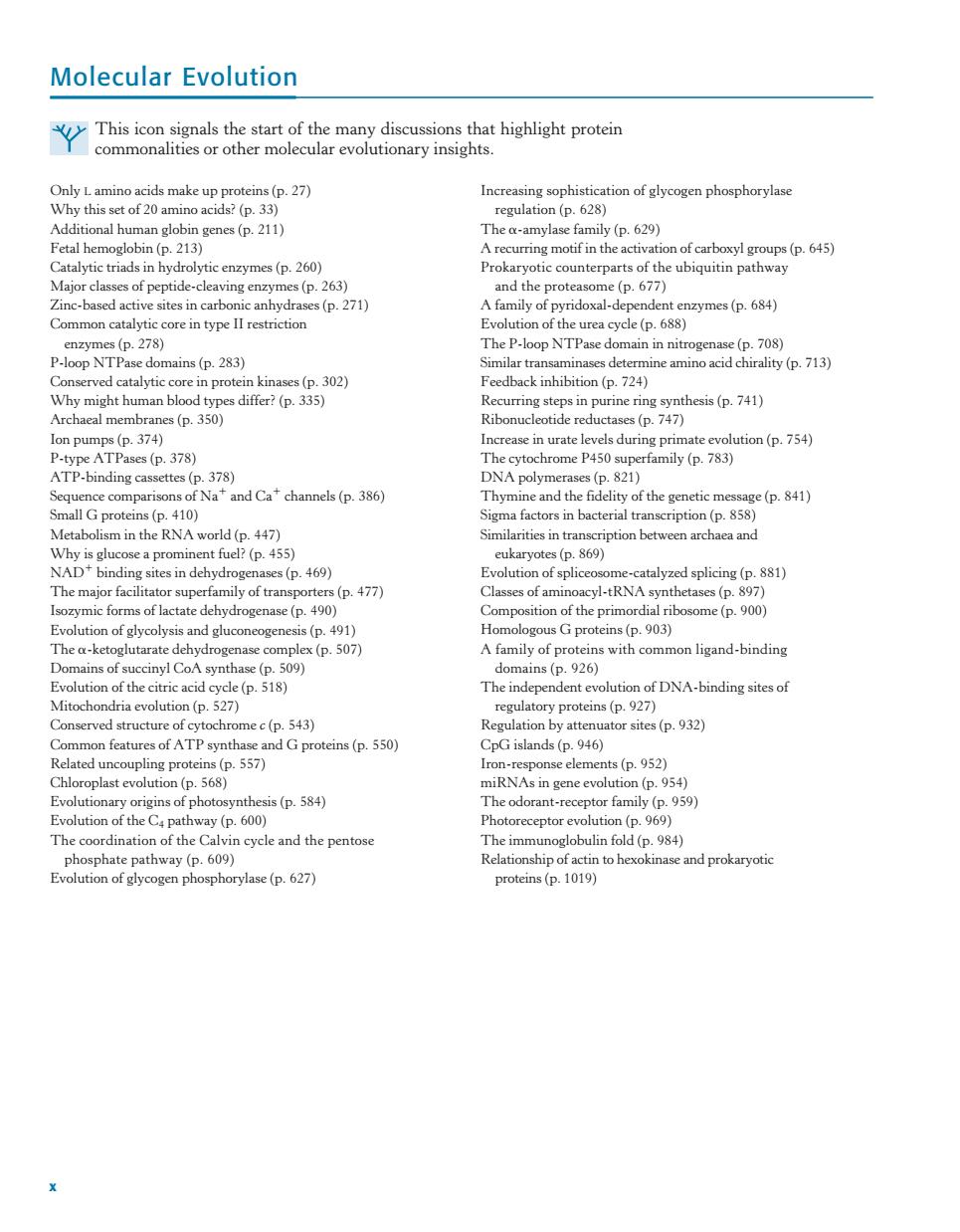正在加载图片...

Molecular Evolution This icon signals the start of the many discussions that highlight protein commonalities or other molecular evolutionary insights. Only Lamino acids make up proteins(p.27) Increasing sophistication of glycogen phosphorylase Why this set of 20 amino acids?(p.33) regulation(p.628) Additional human globin genes(p.211) The a-amylase family (p.629) Fetal hemoglobin(p.213) A recurring motif in the activation of carboxyl groups(p.645) Catalytic triads in hydrolytic enzymes(p.260) Prokaryotic counterparts of the ubiquitin pathway Major classes of peptide-cleaving enzymes(p.263) and the proteasome(p.677) Zinc-based active sites in carbonic anhydrases(p.271) A family of pyridoxal-dependent enzymes(p.684) Common catalytic core in type II restriction Evolution of the urea cycle(p.688) enzymes (p.278) The P-loop NTPase domain in nitrogenase(p.708) P-loop NTPase domains(p.283) Similar transaminases determine amino acid chirality(p.713) Conserved catalytic core in protein kinases(p.302) Feedback inhibition(p.724) Why might human blood types differ?(p.335) Recurring steps in purine ring synthesis(p.741) Archaeal membranes(p.350) Ribonucleotide reductases(p.747) Ion pumps(p.374) Increase in urate levels during primate evolution(p.754) P-type ATPases(p.378) The cytochrome P450 superfamily(p.783) ATP-binding cassettes(p.378) DNA polymerases(p.821) Sequence comparisons of Na and Ca*channels(p.386) Thymine and the fidelity of the genetic message(p.841) Small G proteins (p.410) Sigma factors in bacterial transcription(p.858) Metabolism in the RNA world (p.447) Similarities in transcription between archaea and Why is glucose a prominent fuel?(p.455) eukaryotes(p.869) NAD*binding sites in dehydrogenases(p.469) Evolution of spliceosome-catalyzed splicing(p.881) The major facilitator superfamily of transporters(p.477) Classes of aminoacyl-tRNA synthetases(p.897) Isozymic forms of lactate dehydrogenase(p.490) Composition of the primordial ribosome(p.900) Evolution of glycolysis and gluconeogenesis(p.491) Homologous G proteins(p.903) The a-ketoglutarate dehydrogenase complex(p.507) A family of proteins with common ligand-binding Domains of succinyl CoA synthase(p.509) domains(p.926) Evolution of the citric acid cycle(p.518) The independent evolution of DNA-binding sites of Mitochondria evolution(p.527) regulatory proteins(p.927) Conserved structure of cytochrome c(p.543) Regulation by attenuator sites(p.932) Common features of ATP synthase and G proteins(p.550) CpG islands (p.946) Related uncoupling proteins(p.557) Iron-response elements(p.952) Chloroplast evolution(p.568) miRNAs in gene evolution(p.954) Evolutionary origins of photosynthesis (p.584) The odorant-receptor family(p.959) Evolution of the C pathway(p.600) Photoreceptor evolution(p.969) The coordination of the Calvin cycle and the pentose The immunoglobulin fold (p.984) phosphate pathway(p.609) Relationship of actin to hexokinase and prokaryotic Evolution of glycogen phosphorylase(p.627) proteins(p.1019)x Only L amino acids make up proteins (p. 27) Why this set of 20 amino acids? (p. 33) Additional human globin genes (p. 211) Fetal hemoglobin (p. 213) Catalytic triads in hydrolytic enzymes (p. 260) Major classes of peptide-cleaving enzymes (p. 263) Zinc-based active sites in carbonic anhydrases (p. 271) Common catalytic core in type II restriction enzymes (p. 278) P-loop NTPase domains (p. 283) Conserved catalytic core in protein kinases (p. 302) Why might human blood types differ? (p. 335) Archaeal membranes (p. 350) Ion pumps (p. 374) P-type ATPases (p. 378) ATP-binding cassettes (p. 378) Sequence comparisons of Na1 and Ca1 channels (p. 386) Small G proteins (p. 410) Metabolism in the RNA world (p. 447) Why is glucose a prominent fuel? (p. 455) NAD1 binding sites in dehydrogenases (p. 469) The major facilitator superfamily of transporters (p. 477) Isozymic forms of lactate dehydrogenase (p. 490) Evolution of glycolysis and gluconeogenesis (p. 491) The a-ketoglutarate dehydrogenase complex (p. 507) Domains of succinyl CoA synthase (p. 509) Evolution of the citric acid cycle (p. 518) Mitochondria evolution (p. 527) Conserved structure of cytochrome c (p. 543) Common features of ATP synthase and G proteins (p. 550) Related uncoupling proteins (p. 557) Chloroplast evolution (p. 568) Evolutionary origins of photosynthesis (p. 584) Evolution of the C4 pathway (p. 600) The coordination of the Calvin cycle and the pentose phosphate pathway (p. 609) Evolution of glycogen phosphorylase (p. 627) Increasing sophistication of glycogen phosphorylase regulation (p. 628) The a-amylase family (p. 629) A recurring motif in the activation of carboxyl groups (p. 645) Prokaryotic counterparts of the ubiquitin pathway and the proteasome (p. 677) A family of pyridoxal-dependent enzymes (p. 684) Evolution of the urea cycle (p. 688) The P-loop NTPase domain in nitrogenase (p. 708) Similar transaminases determine amino acid chirality (p. 713) Feedback inhibition (p. 724) Recurring steps in purine ring synthesis (p. 741) Ribonucleotide reductases (p. 747) Increase in urate levels during primate evolution (p. 754) The cytochrome P450 superfamily (p. 783) DNA polymerases (p. 821) Thymine and the fidelity of the genetic message (p. 841) Sigma factors in bacterial transcription (p. 858) Similarities in transcription between archaea and eukaryotes (p. 869) Evolution of spliceosome-catalyzed splicing (p. 881) Classes of aminoacyl-tRNA synthetases (p. 897) Composition of the primordial ribosome (p. 900) Homologous G proteins (p. 903) A family of proteins with common ligand-binding domains (p. 926) The independent evolution of DNA-binding sites of regulatory proteins (p. 927) Regulation by attenuator sites (p. 932) CpG islands (p. 946) Iron-response elements (p. 952) miRNAs in gene evolution (p. 954) The odorant-receptor family (p. 959) Photoreceptor evolution (p. 969) The immunoglobulin fold (p. 984) Relationship of actin to hexokinase and prokaryotic proteins (p. 1019) This icon signals the start of the many discussions that highlight protein commonalities or other molecular evolutionary insights. Molecular Evolution